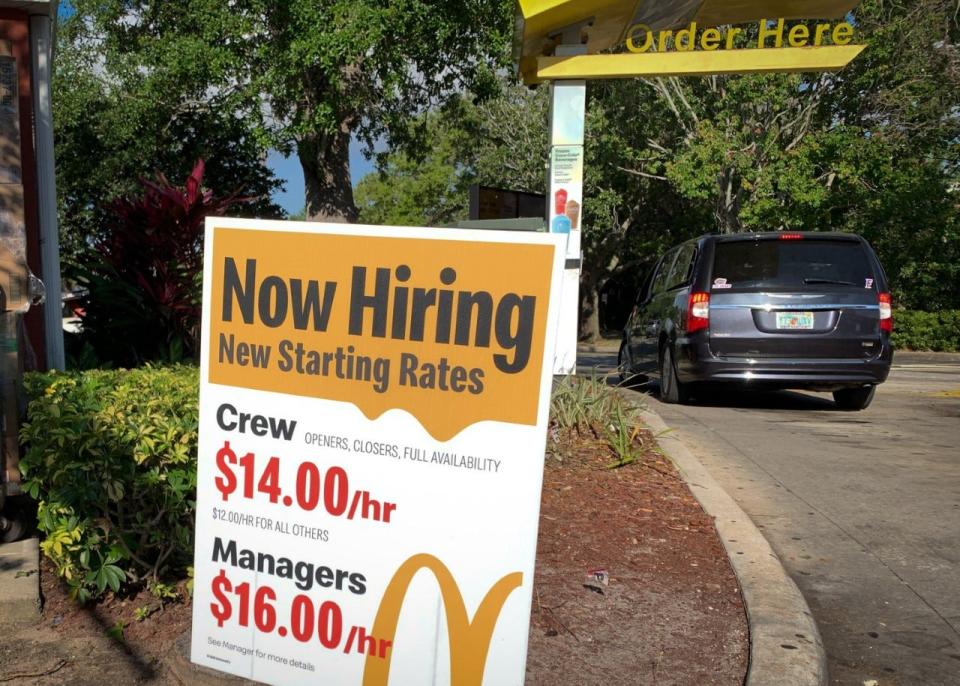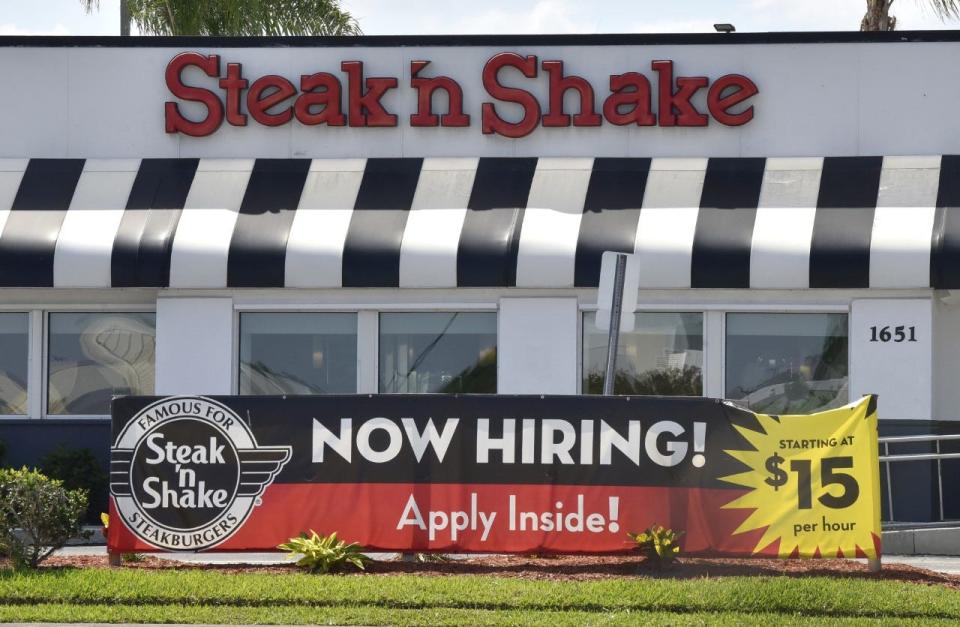'Historically unprecedented': Brevard unemployment rate declines to 2.5% in March
MELBOURNE — Brevard County posted a "historically unprecedented" record-low unemployment rate of 2.5% last month, according to new data released by the state.
The March rate is lower than the previous record low of 2.6%, set in December 2021, according to data compiled by the Florida Department of Economic Opportunity that goes back to 1991. In comparison, Brevard's record-high unemployment rate during that time span was 12.4% in April 2020, as employers were in the midst of COVID-19-related layoffs.

"The 2.5% rate is historically unprecedented," said Marci Murphy, president of CareerSource Brevard. "It creates a unique challenge to employers, as they continue to try to fill their open jobs."
Brevard's 2.5% unemployment rate is down from 2.9% in February and 4.5% in March 2021.
Florida's unemployment rate was 3.2% in March, down from 3.3% in February and 5.4% in March 2021.
The national unemployment rate was 3.6% in March, down from 3.8% in February and 6.0% in March 2021.
Florida's unemployment rate has been below the national rate for 16 straight months, since December 2020.

Looking for candidates: With low unemployment rate, Brevard employers struggle to fill job openings
Declining jobless trend: Brevard unemployment rate dropped to 2.9% in February, compared with 3.3% in January
The national and state unemployment rates are adjusted to reflect seasonal changes in the job market, such as for pre-Christmas hiring, and for the start and end of the school year. The rates for individual counties are not seasonally adjusted.
The Department of Economic Opportunity counted 285,854 employed residents in Brevard in March, up from 283,342 in February and 273,213 in March 2021
It said there were 7,316 unemployed residents in Brevard in March who were actively looking for work. That's down from 8,490 in February and 12,992 in March 2021.
The number of non-agricultural jobs in Brevard grew by 500, or 0.2%, from February and grew by 7,700, or 3.3%, since March 2021.
Challenges for employers

With relatively few unemployed people, that creates challenges for employers seeking to fill job openings.
Murphy said one of CareerSource Brevard’s efforts is to "find hidden talent, which can include underserved populations and people with barriers to employment. Additionally, we strategize with employers to find ways they can re-engage talent, for example, by encouraging someone out of retirement by offering a flexible schedule or part-time hours."
Additionally, Murphy said CareerSource Brevard "continues to work with the Brevard County School system and other educational institutions, as well as community partners and businesses, to develop the talent pipelines our key industries need."
The search for job candidates has been an issue statewide as well.
There were 339,000 unemployed Floridians in March out of a labor force of 10,513,000, the state said. At the same time, there were nearly 510,000 online job postings in March from employers seeking job candidates.
The number of employed Floridians has increased 0.5% in a month and 5.5% in the last year.
The number of unemployed Floridians has decreased 2.3% in a month and 37.9% in the last year.
The state gained 497,800 jobs over the year, an increase of 5.7%. Nationally, the number of jobs rose 4.5% over the year.
"The combination of falling unemployment rate and a growing labor force is a very good sign for Florida's economy," Adrienne Johnston, chief economist for the Florida Department of Economic Opportunity, said during a media briefing coinciding with the release of the data Friday. "This means that more and more Floridians continue to enter the job market, and that they are able to find work on a consistent basis."
She said there are no signs in Florida of an economic slowdown.
Johnston also noted that the share of unemployed people who voluntarily left their jobs has increased for 12 consecutive months. "This indicates that individuals are more optimistic about their ability to find work if they leave their current job," she said.
During an appearance Friday in Dixie County, in the state's Big Bend region, Gov. Ron DeSantis touted the increase in manufacturing jobs in the state, and noted Florida's efforts to push career and technical education programs.
"I think we have the capacity to make more stuff here," DeSantis said. "We've got a good economic climate. Low taxes. But now we have that dedication to workforce. I want to see more things being made here."
The state added 4,500 manufacturing jobs in March, which Johnston said is the third-largest single-month growth in that sector since 1990.
Overall, Florida lost 1,282,500 jobs from February to April 2020, as pandemic-related layoffs were occurring, and has since gained back 1,438,500 jobs.
Six of Florida's 10 major industries have gained back the number of the jobs lost during the pandemic. These industries are construction; financial activities; information; manufacturing; professional and businesses services; and trade, transportation and utilities.
"As Florida continues to add jobs and surpass February 2020 economic activity," Johnston said, there have been "some potential shifts in the labor market away from jobs in hotels, restaurants and entertainment venues, and toward jobs in professional services and goods-oriented sectors like manufacturing, construction, and transportation, warehousing and logistics."
Johnston added that the biggest job growth also is generally in higher-paying job sectors.
DeSantis also cited this data in a separate statement on the economic data:
Florida’s unemployment rate has remained below the national rate for 16 consecutive months while trending downward or holding steady for 20 consecutive months.
Florida’s private-sector job growth has exceeded the nation’s for 12 consecutive months since April 2021.
Florida employers have added jobs for 23 consecutive months since May 2020.
Where Brevard jobs increased
In Brevard, eight of the 10 major industries gained jobs in the past year, according to data compiled by CareerSource Brevard.
The industries gaining in jobs over the year were leisure and hospitality (2,500 jobs); trade, transportation and utilities (2,300 jobs); professional and business services (1,100 jobs); government (600 jobs); manufacturing (500 jobs); other services (500 jobs); information (300 jobs); and financial activities (100 jobs).
The construction, mining and logging industry 200 lost jobs over the year.
Jobs in the education and health services industry remained unchanged over the year.
Where Brevard ranks
At 2.5%, Brevard County was tied for having the 21st-lowest unemployment rate among the state's 67 counties in March. It was tied for having the sixth-lowest unemployment rate among the state's 24 metro areas.
Monroe County, which contains the Florida Keys, had the state’s lowest unemployment rate in March (1.7%), followed by St. Johns County (2.0%), Okaloosa and Wakulla counties (2.1% each), and Collier, Nassau and Union counties (2.2% each).
Highlands County, which sits northwest of Lake Okeechobee, had the highest unemployment rate (3.9%) in March, followed by Putnam County (3.8%), Citrus and Hamilton counties (3.7% each), and Sumter County (3.6%).
Among Florida's metro areas, the lowest unemployment rate was 2.1% in Crestview/Fort Walton Beach/Destin. The highest rate was 3.9% in Sebring, which also was the only one of the 24 metro areas to suffer a job loss over the last year.
Municipal data
The DEO also tracks unemployment rates for Brevard's five most populous cities. Here are those numbers:
Melbourne: 2.7% in March, down from 3.3% in February. The rate peaked at 13.0% in April 2020 and was 2.7% just before the pandemic in February 2020.
Palm Bay: 2.9% in March, down from 3.2% in February. The rate peaked at 12.6% in April 2020 and was 2.8% just before the pandemic in February 2020.
Rockledge: 2.3% in March, down from 2.7% in February. The rate peaked at 11.5% in April 2020 and was 2.6% just before the pandemic in February 2020.
Titusville: 2.6% in March, down from 3.3% in February. The rate peaked at 14.5% in April 2020 and was 2.9% just before the pandemic in February 2020.
West Melbourne: 2.2% in March, down from 2.8% in February. Data for West Melbourne was not tracked separately in 2020.
The DEO will release April jobs data for Florida and its counties May 20.
Dave Berman is business editor at FLORIDA TODAY. Contact Berman at dberman@floridatoday.com. Twitter: @bydaveberman.
Support local journalism and journalists like me. Subscribe today.
This article originally appeared on Florida Today: Brevard unemployment rate of 2.5% is lowest figure since at least 1991

